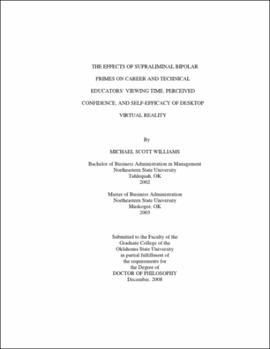| dc.contributor.advisor | Ausburn, Lynna | |
| dc.contributor.author | Williams, Michael Scott | |
| dc.date.accessioned | 2013-11-26T08:35:01Z | |
| dc.date.available | 2013-11-26T08:35:01Z | |
| dc.date.issued | 2008-12 | |
| dc.identifier.uri | https://hdl.handle.net/11244/7628 | |
| dc.description.abstract | Scope and Method of Study: | |
| dc.description.abstract | Virtual reality (VR) has been demonstrated to offer learning benefits in many technical and occupational areas. This study used Rogers' innovation diffusion theory and stimulus priming theory to study the effects of supraliminal priming on viewing time, confidence, and VR self-efficacy of desktop VR in Career and Technical Education. The study was informed and refined by a pilot study and used experimental methodology to test the possibility of positively influencing the dispositions of occupational educators toward desktop VR through application of prime theory. Supraliminal bipolar primes in the form of scrambled sentences were used to test whether a positive disposition more conducive to future VR adoption could be created in a sample of 45 occupational educators prior to introduction of a desktop VR presentation, with "disposition" defined as voluntary VR viewing time, self-reported VR confidence, and self-reported VR self-efficacy on 5-point Likert-scales. | |
| dc.description.abstract | Findings and Conclusions: | |
| dc.description.abstract | The inquiry used descriptive statistics, analysis of variance, and correlation statistical analyses to produce results that were expected and unexpected given the indications of the pilot study. The conclusions resulting from this study are: | |
| dc.description.abstract | 1. Several aspects of the study's proposed theoretical/conceptual framework were supported. | |
| dc.description.abstract | 2. There were some disparities between the outcomes of the pilot and the present study that may be related to sample size. | |
| dc.description.abstract | 3. Priming may be able to directly affect VR viewing time, VR confidence, and VR Self-efficacy. | |
| dc.description.abstract | 4. Relationships among priming, VR viewing time, confidence, and self-efficacy may be more complex than predicted in the proposed conceptual framework. | |
| dc.description.abstract | 5. A relationship between VR confidence and self-efficacy may exist and may be complex. | |
| dc.format | application/pdf | |
| dc.language | en_US | |
| dc.rights | Copyright is held by the author who has granted the Oklahoma State University Library the non-exclusive right to share this material in its institutional repository. Contact Digital Library Services at lib-dls@okstate.edu or 405-744-9161 for the permission policy on the use, reproduction or distribution of this material. | |
| dc.title | Effects of supraliminal bipolar primes on career and technical educators' viewing time, perceived confidence, and self-efficacy of desktop virtual reality | |
| dc.contributor.committeeMember | Self, Mary Jo | |
| dc.contributor.committeeMember | Conti, Gary | |
| dc.contributor.committeeMember | Kutz, Mary | |
| dc.contributor.committeeMember | Ausburn, Floyd | |
| osu.filename | Williams_okstate_0664D_10015.pdf | |
| osu.accesstype | Open Access | |
| dc.type.genre | Dissertation | |
| dc.type.material | Text | |
| dc.subject.keywords | experimental | |
| dc.subject.keywords | innovation diffusion | |
| dc.subject.keywords | priming | |
| dc.subject.keywords | self efficacy | |
| dc.subject.keywords | self-efficacy | |
| dc.subject.keywords | virtual reality | |
| thesis.degree.discipline | Education | |
| thesis.degree.grantor | Oklahoma State University | |
